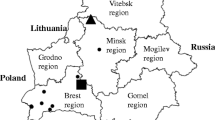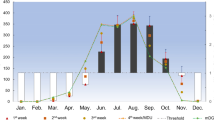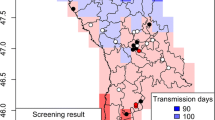Abstract
After the repeated demonstration of Dirofilaria repens infections in German dogs, D. repens and Dirofilaria immitis DNA was detected in mosquitoes trapped in 2011, 2012 and 2013 in northeastern and southwestern Germany within the framework of culicid monitoring projects. As temperature is the most important factor dictating the extrinsic development of dirofilarial larvae in the potential vector, data of the German Weather Service (DWD) were analysed for the regions where the positive mosquitoes had been collected. Based on the mean daily temperatures recorded by weather stations most closely to the collection sites of the mosquitoes, it can be concluded that the mosquitoes were trapped in time periods that allowed for the completion of the developmental cycle of the worms in the mosquitoes and a subsequent transmission to a vertebrate host. The results of this study confirm the principal climatic suitability of certain German regions for the establishment of natural dirofilarial transmission cycles. Moreover, the theoretical climatic considerations, together with findings of D. repens infections in German dogs and mosquitoes, strongly suggest that the continuing spread of at least D. repens from its traditional habitats in the Mediterranean has reached southwestern and northeastern Germany.





Similar content being viewed by others
References
Bocková E, Rudolf I, Kočišová A, Betášová L, Venclíková K, Mendel J, Hubálek Z (2013) Dirofilaria repens microfilariae in Aedes vexans mosquitoes in Slovakia. Parasitol Res 112:3465–3470
Cielecka D, Zarnowska-Prymek H, Masny A, Salamatin R, Wesolowska M, Golab E (2012) Human dirofilariosis in Poland: the first cases of autochthonous infections with Dirofilaria repens. Ann Agric Environ Med 19:445–450
Czajka C, Becker N, Jöst H, Poppert S, Schmidt-Chanasit J, Krüger A, Tannich E (2014) Stable transmission of Dirofilaria repens nematodes, Northern Germany. Emerg Infect Dis 20:328–330
Duscher G, Feiler A, Wille-Piazzai W, Bakonyi T, Leschnik M, Miterpáková M, Kolodziejek J, Nowotny N, Joachim A (2009) Detection of Dirofilaria in Austrian dogs. Berl Munch Tierarztl Wochenschr 122:199–203 [Article in German]
DWD (2013) Global temperature will increase in the long run despite present stagnation. DWD press release, 7 May 2013 [Article in German] (http://www.dwd.de/bvbw/appmanager/bvbw/dwdwwwDesktop?_nfpb = true&_pageLabel = dwdwww_menu2_presse&T98029gsbDocumentPath = Content%2FPresse%2FPressemitteilungen%2 F2013%2F20130507__Klima__PK__news.html, accessed April 11 2014)
Fortin JF, Slocombe JOD (1981) Temperature requirements for the development of Dirofilaria immitis in Aedes triseriatus and Ae. vexans. Mosq News 41:625–633
Genchi C, Rinaldi L, Cascone C, Mortarino M, Cringoli G (2005) Is heartworm disease really spreading in Europe? Vet Parasitol 133:137–148
Genchi C, Rinaldi L, Mortarino M, Genchi M, Cringoli G (2009) Climate and Dirofilaria infection in Europe. Vet Parasitol 163:286–292
Genchi C, Mortarino M, Rinaldi L, Cringoli G, Traldi G, Genchi M (2011a) Changing climate and changing vector-borne disease distribution: the example of Dirofilaria in Europe. Vet Parasitol 176:295–299
Genchi C, Kramer LH, Rivasi F (2011b) Dirofilarial infections in Europe. Vector Borne Zoon Dis 11:1307–1317
Hermosilla C, Pantchev N, Dyachenko V, Gutmann M, Bauer C (2006) First autochthonous case of canine ocular Dirofilaria repens in Germany. Vet Rec 158:134–135
Iglódyová A, Miterpáková M, Hurníková Z, Antolová D, Dubinský P, Letková V (2012) Canine dirofilariosis under specific environmental conditions of the eastern Slovak Lowland. Ann Agric Environ Med 19:57–60
Jacso O, Mandoki M, Majoros G, Petsch M, Mortarino M, Genchi C, Fok E (2009) First autochthonous Dirofilaria immitis (Leidy, 1856) infection in a dog in Hungary. Helminthologia 46:159–161
Kronefeld M, Kampen H, Sassnau R, Werner D (2014) Molecular evidence for the occurrence of Dirofilaria immitis, Dirofilaria repens and Setaria tundra in mosquitoes from Germany. Parasit Vectors 7:30
Mircean V, Dumitrache MO, Györke A, Pantchev N, Jodies R, Mihalca AD, Cozma V (2012) Seroprevalence and geographic distribution of Dirofilaria immitis and tick-borne infections (Anaplasma phagocytophilum, Borrelia burgdorferi sensu lato, and Ehrlichia canis) in dogs from Romania. Vector Borne Zoon Dis 12:595–604
Miterpáková M, Antolová D, Hurníková Z, Dubinský P, Pavlacka A, Németh J (2010) Dirofilaria infections in working dogs in Slovakia. J Helminthol 84:173–176
Morchón R, Carretón E, González-Miguel J, Mellado-Hernández I (2012) Heartworm disease (Dirofilaria immitis) and their vectors in Europe—new distribution trends. Front Physiol 3:196
Overgaauw P, van Dijk E (2009) Autochthonous case of Dirofilaria repens in a dog in the Netherlands. Vet Rec 164:158
Pantchev N, Norden N, Lorentzen L, Rossi U, Brand B, Dyachenko V (2009) Current surveys on the prevalence and distribution of Dirofilaria spp. in dogs in Germany. Parasitol Res 105(Suppl 1):63–74
Pantchev N, Etzold M, Daugschies A, Dyachenko V (2011) Diagnosis of imported canine filarial infections in Germany 2008-2010. Parasitol Res 109(Suppl 1):61–76
Sałamatin RV, Pavlikovska TM, Sagach OS, Nikolayenko SM, Kornyushin VV, Kharchenko VO, Masny A, Cielecka D, Konieczna-Sałamatin J, Conn DB, Golab E (2013) Human dirofilariasis due to Dirofilaria repens in Ukraine, an emergent zoonosis: epidemiological report of 1465 cases. Acta Parasitol 58:592–598
Sassnau R, Genchi C (2013) Qualitative risk assessment for the endemisation of Dirofilaria repens in the state of Brandenburg (Germany) based on temperature-dependent vector competence. Parasitol Res 112:2647–2652
Sassnau R, Dyachenko V, Pantchev N, Stöckel F, Dittmar K, Daugschies A (2009) Dirofilaria repens-Befall in einem Schlittenhunde-Rudel im Land Brandenburg. Tierarztl Prax 37(K):95–101
Sassnau R, Kohn M, Demeler J, Kohn B, Müller E, Krücken J, von Samson-Himmelstjerna G (2013) Is Dirofilaria repens endemic in the Havelland District in Brandenburg, Germany? Vector Borne Zoon Dis 13:888–891
Simón F, Siles-Lucas M, Morchón R, González-Miguel J, Mellado I, Carretón E, Montoya-Alonso JA (2012) Human and animal dirofilariasis: the emergence of a zoonotic mosaic. Clin Microbiol Rev 25:507–544
Świątalska A, Demiaszkiewicz AW (2012) First autochthonous case of Dirofilaria immitis invasion in dog in Poland. Žycie Weterynaryjne 87:685–686 [Article in Polish]
Szénási Z, Kovács AH, Pampiglione S, Fioravanti ML, Kucsera I, Tánczos B, Tiszlavicz L (2008) Human dirofilariosis in Hungary: an emerging zoonosis in central Europe. Wien Klin Wochenschr 120:96–102
Venco L, Genchi M, Genchi C, Gatti D, Kramer L (2011) Can heartworm prevalence in dogs be used as provisional data for assessing the prevalence of the infection in cats? Vet Parasitol 176:300–303
Víchová B, Miterpáková M, Iglódyová A (2014) Molecular detection of co-infections with Anaplasma phagocytophilum and/or Babesia canis canis in Dirofilaria-positive dogs from Slovakia. Vet Parasitol. 203:167–172 doi:10.1016/j.vetpar.2014.01.022 [Epub ahead of print]
Webber WA, Hawking F (1955) Experimental maintenance of Dirofilaria repens and Dirofilaria immitis in dogs. Exp Parasitol 4:143–164
Competing interests
The authors declare that they have no competing interests.
Author information
Authors and Affiliations
Corresponding author
Rights and permissions
About this article
Cite this article
Sassnau, R., Czajka, C., Kronefeld, M. et al. Dirofilaria repens and Dirofilaria immitis DNA findings in mosquitoes in Germany: temperature data allow autochthonous extrinsic development. Parasitol Res 113, 3057–3061 (2014). https://doi.org/10.1007/s00436-014-3970-1
Received:
Accepted:
Published:
Issue Date:
DOI: https://doi.org/10.1007/s00436-014-3970-1




